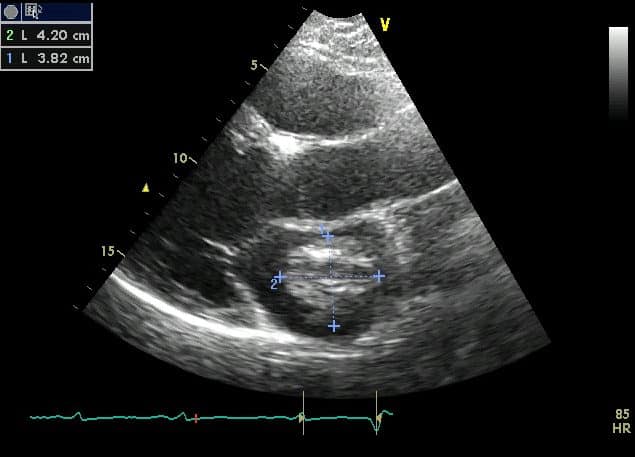Introduction
Cardiac tumours can either be primary tumour or secondary metastatic deposits. Reassuringly, the vast majority of primary tumours are benign in nature (~90%), however the small proportion that are malignant are associated with very poor prognosis.
Secondary metastatic cardiac tumours are 20-40 times more common than primary malignancies, most commonly seen with melanoma, breast, lung, or oesophageal tumours as the primary origin.
Primary Cardiac Tumours
Atrial Myxoma
The most common benign cardiac mass in adults, which originate from endocardial tissue. They most frequently occur in the atria, specifically the left atrium. They most commonly arise from the atrial septum at the fossa ovalis. Atrial myxoma can be classified into either polypoid and papillary myxoma; polypoid myxomas tend to cause obstructive symptoms, whereas papillary myxomas present with embolic events.
Rhabdomyoma
Rhabdomyoma are the most common benign cardiac tumour in children. They usually present with arrhythmias and symptoms of heart failure. However, they commonly spontaneously regress and as such, no intervention is typically required outside of serial monitoring.

Figure 2 – Histology of benign cardiac tumours (A) Myxoma (B) Rhabdomyoma
Malignant Tumours
The main types of malignant cardiac tumour are sarcomas (angiosarcoma, leiomyosarcoma, rhabdomyosarcoma), lymphoma (mainly B-cell lymphoma), and mesothelioma. Unfortunately, whilst rare, prognosis is poor, with a median survival of around 40% at 12months
Clinical Features
Cardiac tumours are often asymptomatic and usually identified as an incidental finding. Manifestations of cardiac tumours vary and are largely dependent on the location, size, and aetiology of the tumour.
Those that disrupt normal valvular function can result in clinical features of valvular disease. Pedunculated tumours can block valve orifices leading to sudden cardiac death. Less commonly patients can develop arrhythmias or pericardial effusions secondary to cardiac malignancy.
Cardiac tumours can also embolise and result in pulmonary embolism, stroke, or limb ischaemia. Malignant cardiac tumours can present with systemic symptoms, such as weight loss, lethargy, or paraneoplastic symptoms.
Investigations
The mainstay of investigation is via echocardiography (ECHO, Fig 2), typically transthoracic however transoesophageal may be required for better characterisation (especially with valvular lesions).
Most cardiac malignancies can be diagnosis on clinical features and imaging alone, however biopsy can be required on occasion (especially in suspected malignant cases)
Further work-up with cardiac MRI (Fig. 3) and PET-CT can be performed for cases of unclear aetiology or suspected malignancy.
Management
In benign tumours, surgery should be considered for all patients that are symptomatic and in those with left-sided endocavitary lesions (due to the embolic risk). Asymptomatic patients with right-sided lesions can often adopt a watch-and-wait approach with regular ECHOs.
For non-metastatic malignant cardiac tumours, surgery should also be considered, often also requiring neoadjuvant and/or adjuvant chemotherapy. However, for metastatic cases, palliation may be required (palliative surgery may be considered in secondary cardiac tumours for symptomatic benefits).

Figure 3 – A cardiac myxoma, as seen on cardiac MRI
Surgical Intervention
The surgical approach for removal of cardiac tumours generally involves a median sternotomy and placing the patient on cardiopulmonary bypass.
A right, left, or combined atriotomy is then performed, depending on the site of the tumour, with the tumour excised with wide surgical margins to minimise the risk of recurrence. Often continuity of the atrial septum is disrupted by excision, mandating primary repair or patch repair with a pericardial patch.
Exploration of all chambers is normally required, however in cases single-sided atriotomy and resection with exploration of chambers on that side of the heart only may be acceptable in the presence of an ECHO showing no other lesions.
Key Points
- The vast majority of primary tumours are benign, however those are malignant are associated with a very poor prognosis
- Cardiac tumours are often asymptomatic and usually identified as an incidental finding
- The mainstay of investigation is via ECHO
- In benign tumours, surgery should be considered for all patients that are symptomatic and in those with left-sided endocavitary lesions; for non-metastatic malignant cardiac tumours, surgery should also be considered, often also requiring neoadjuvant and/or adjuvant chemotherapy


